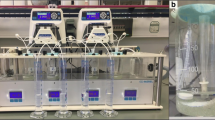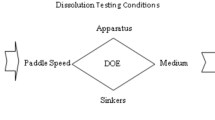ABSTRACT
This study described a pH-gradient dissolution method combined with flux measurements as an in vitro tool for assessing the risk of bioavailability reduction due to drug-drug interactions (DDI) caused by acid reducing agents (ARAs). The device incorporates absorption chambers into USP II dissolution vessels, with fiber optic UV-probes monitoring concentration in situ. Dosage forms of Genentech BCS class II drugs, GDC-0810, GDC-0941, and compound A, were tested by starting the dissolution in either pH 1.6 or pH 4.0 media then converting to FaSSIF after 30 min. GDC-0810 showed no significant difference in flux between the two conversion experiments. A supersaturation phase was observed for GDC-0941 in the pH 1.6 experiments after media conversion to FaSSIF; however, it did not appear to occur in the pH 4.0 experiment due to low drug solubility at pH 4.0, resulting in a 95% decrease in flux compared to pH 1.6 experiment. The extent of flux reduction and the total accumulated API mass in the absorption chamber agreed well with the 89% reduction in mean Cmax and the 82% reduction in mean AUC from dog PK study between animals treated with pentagastrin and famotidine. Testing of the compound A optimized formulation tablets showed a 25% reduction in flux and in vitro absorbed amount by changing pH 1.6 to 4.0, correlating well with the AUC decrease in clinical studies. Good correlation between in vitro data and in vivo PK data demonstrated the applicability of the method for formulators to develop drug products mitigating DDI from ARAs.






Similar content being viewed by others
References
Elder DP. Effective formulation development strategies for poorly soluble active pharmaceutical ingredients (APIs). Am Pharm Rev. 2011;12(2):56–61.
Lignet F, Sherbetjian E, Kratochwil N, Jones R, Suenderhauf C, Otteneder MB, et al. Parrott N characterization of pharmacokinetics in the Gottingen minipig with reference human drugs: an in vitro and in vivo approach. Pharm Res. 2016;33:2565–79.
Zhang T, Heimbach T, Lin W, Zhang J, He HD. Prospective predictions of human pharmaceutics for eighteen compounds. J Pharm Sci. 2015;104:2795–806.
Bhattachar SN, Perkins EJ, Tan JS, Burns LJ. Effect of gastric pH on the pharmacokinetics of a BCS class II compound in dogs: utilization of an artificial stomach and duodenum dissolution model and GastroPlus™ simulations to predict absorption. J Pharm Sci. 2011;100:4756–65.
Tsume Y, Mudie DM, Langguth P, Amidon GE, Amidon GL. The biopharmaceutics classification system: subclasses for in vivo predictive dissolution (IPD) methodology and IVIVC. Eur J Pharm Sci. 2014;57:152–63.
Lainé AL, Price D, Davis J, Roberts D, Hudson R, Back K, et al. Enhanced oral delivery of celecoxib via the development of a supersaturable amorphous formulation utilizing mesoporous silica and co-loaded HPMCAS. In J Pharm. 2016;512:118–25.
Van Speybroeck M, Mols R, Mellaerts Randy R, Thi TD, Martens JA, Van Humbeeck J, et al. Combined use of ordered mesoporous silica and precipitation inhibitors for improved oral absorption of the poorly soluble weak base itraconazole. Eur J Pharm Biopharm. 2010;75:354–65.
Lui CY, Amidon GL, Berardi RR, Fleisher D, Youngberg C, Dressman JB. Comparison of gastrointestinal pH in dogs and humans: implications on the use of the beagle dogs as a model for oral absorption in humans. J Pharm Sci. 1986;75:271–4.
Pang J, Dalziel G, Dean B, Ware JA, Salphati L. Pharmacokinetics and absorption of the anticancer agents dasatinib and GDC-0941 under various gastric conditions in dogs—reversing the effect of elevated gastric pH with betaine HCl. Mol Pharm. 2013;10:4024–31.
Mitra A, Kesisoglou F, Beauchamp M, Zhu W, Chiti F, Wu Y. Using absorption simulation and gastric pH modulated dog model for formulation development to overcome achlorhydria effect. Mol Pharm. 2011;8:2216–23.
Targownik LE, Metge C, Roos L, Leung S. The prevalence of and the clinical and demographic characteristics associated with high-intensity proton pump inhibitor use. Am J Gastroenterol. 2007;102:942–50.
Smelick GS, Heffron TO, Chu L, Dean B, West DA, DuVall SL, et al. Prevalence of acid-reducing agents (ARAs) in cancer patients and ARA drug-drug interaction potential for molecular targeted agents in clinical development. Mol Pharm. 2013;10:4055–62.
Koneru B, Cowart DT, Noorisa M, Kisicki J, Bramer SL. Effect of increasing gastric pH with famotidine on absorption and oral pharmacokinetics of the inotropic agent vesnarinone. J Clin Pharmacol. 1998;38:429–32.
Budha NR, Frymoyer A, Smelick GS, Jin JY, Yago MR, Dresser MJ, et al. Drug absorption interactions between oral targeted anticancer agents & PPIs: is pH-dependent solubility the achilles heel of targeted therapy? Clin Pharmacol Ther. 2012;92:203–13.
Lahner E, Annibale B, Fave GD. Systemic review: impaired drug absorption related to the co-administration of antisecretory therapy. Aliment Pharmacol Ther. 2009;29:1219–29.
Badawy SIF, Gray DB, Zhao F, Sun DX, Schuster AE, Hussain MA. Formulation of solid dosage forms to overcome gastric pH interaction of factor Xa inhibitor, BMS-561389. Pharm Res. 2006;23:989–96.
Kostewicz ES, Abrahamsson B, Brewster M, Brouwers J, Butler J, Carlert C, et al. In vitro models for the prediction of in vivo performance of oral dosage forms. Eur J Pharm Sci. 2014;57:342–66.
Klein S. The use of Biorelevant dissolution media to forecast the in vivo performance of a drug. AAPS J. 2010;12:397–406.
Klein S, Dressman JB. Comparison of drug release from metoprolol modified released forms in single buffer versus a pH-gradient dissolution test. Dissolution Technologies. 2006;13:6–11.
Mathias NR, Xu Y, Patel D, Grass M, Caldwell B, Jager C, et al. Assessing the risk of pH-dependent absorption for new molecular entities: a novel in vitro dissolution test, physicochemical analysis and risk assessment strategy. Mol Pharm. 2013;10:4063–73.
Gao P, Shi Y. Characterization of supersaturatable formulations for improved absorption of poorly soluble drugs. AAPS J. 2012;14:703–13.
Kou D, Dwaraknath S, Fischer Y, Nguyen D, Kim M, Yiu H, et al. Biorelevant dissolution models for a weak base to facilitate formulation development and overcome reduced bioavailability caused by hypochlorhydria or achlorhydria. Mol Pharm. 2017;10:3577–87.
Pestieau A, Evrard B. In vitro biphasic dissolution tests and their suitability for establishing in vitro-in vivo correlations: a historical review. Eur J Pharm Sci. 2017;102:203–19.
Xu H, Shi Y, Vela S, Marroum P, Gao P. Developing quantitative in vitro-in vivo correlation for fenofibrate immediate-release formulations with the biphasic dissolution–partition test method. J Pharm Sci. 2018;107:476–87.
Heigoldt U, Sommer F, Daniels R, Wagner K-G. Predicting in vivo absorption behavior of oral modified release dosage forms containing pH-dependent poorly soluble drugs using a novel pH-adjusted biphasic in vitro dissolution test. Eur J Pharm Biopharm. 2010;75:105–11.
Deng J, Staufenbiel S, Bodmeier R. Evaluating a biphasic in vitro dissolution test for estimating the bioavailability of carbamazepine polymorphic forms. Eur J Pharm Sci. 2017;105:64–70.
Kataoka M, Masaoka Y, Sakuma S, Yamashita S. Effect of food intake on the oral absorption of poorly water-soluble drugs: in vitro assessment of drug dissolution and permeation assay system. J Pharm Sci. 2006;95(9):2051–61.
Kataoka M, Fukahori M, Ikemura A, Kubota A, Higashino H, Sakuma S, et al. Effects of gastric pH on oral drug absorption: in vitro assessment using a dissolution/permeation system reflecting the gastric dissolution process. Eur J Pharm Biopharm. 2016;101:103–11.
Raina SA, Zhang GGZ, Alonzo DE, Wu J, Zhu D, Catron ND, et al. Enhancements and limits in drug membrane transport using supersaturated solutions of poorly water soluble drugs. J Pharm Sci. 2014;103(9):2736–48.
Zhu A, Ho MC, Gemski CK, Chuang BC, Liao M, Xia C. Utilizing in vitro dissolution-permeation chamber for the quantitative predication of pH-dependent drug-drug interactions with acid-reducing agents: a comparison with physiologically based pharmacokinetic modeling. AAPS J. 2016;18:1512–23.
Kansy M, Senner F, Gubernator K. Physicochemical high throughput screening: parallel artificial membrane permeation assay in the description of passive absorption processes. J Med Chem. 1998;41:1007–10.
Avdeef A, Artursson P, Neuhoff S, Lazorova L, Grasjoe J, Tavelin S. Caco-2 permeability of weakly basic drugs predicted with the double-sink PAMPA pKfluxa method. Eur J Pharm Sci. 2005;24:333–49.
Bermejo M, Avdeef A, Ruiz A, Nalda R, Ruell JA, Tsinman O, et al. PAMPA—a drug absorption in vitro model 7. Comparing rat in situ, Caco-2, and PAMPA permeability of fluoroquinolones. Eur J Pharm Sci. 2004;21:429–41.
Forner K, Holm R, Morakul B, Junyaprasert VB, Ackermann M, Mazur J, et al. Dissolution and dissolution/permeation experiments for predicting systemic exposure following oral administration of the BCS class II drug clarithromycin. Eur J Pharm Sci. 2017;101:211–9.
Borbás E, Nagy ZK, Nagy B, Balogh A, Farkas B, Tsinman O, et al. The effect of formulation additives on in vitro dissolution-absorption profile and in vivo bioavailability of telmisartan from brand and generic formulations. Eur J Pharm Sci. 2018;114(January):310–7. Available from: http://linkinghub.elsevier.com/retrieve/pii/S0928098717306954
Hou HH, Jia W, Liu L, Cheeti S, Li J, Nauka E, et al. Effect of microenvironmental pH modulation on the dissolution rate and oral absorption of the salt of a weak acid—case study of GDC-0810. Pharm Res. 2018;35(2):37. https://doi.org/10.1007/s11095-018-2347-z.
Avdeef A, Bendels S, Tsinman O, Tsinman K, Kansy M. Solubility-excipient classification gradient maps. Pharm Res. 2007;24(3):530–45.
Acknowledgements
The authors would like to recognize contribution of Mr. Ram Lingamaneni of Pion Inc. (currently at Catalent) who helped collecting data presented in this paper. The authors would like to acknowledge Drs. Dawen Kou and Mark Ragains of Genentech for their input during the execution of the project, Dr. Gena Dalziel of Genentech for GDC-0941 discussions, and Dr. Lichuan Liu of Genentech for technical discussions on GDC-0810 during the manuscript preparation.
Author information
Authors and Affiliations
Corresponding author
Additional information
Guest Editor: Sandra Klein
Rights and permissions
About this article
Cite this article
Li, J., Tsinman, K., Tsinman, O. et al. Using pH Gradient Dissolution with In-Situ Flux Measurement to Evaluate Bioavailability and DDI for Formulated Poorly Soluble Drug Products. AAPS PharmSciTech 19, 2898–2907 (2018). https://doi.org/10.1208/s12249-018-1164-3
Received:
Accepted:
Published:
Issue Date:
DOI: https://doi.org/10.1208/s12249-018-1164-3




